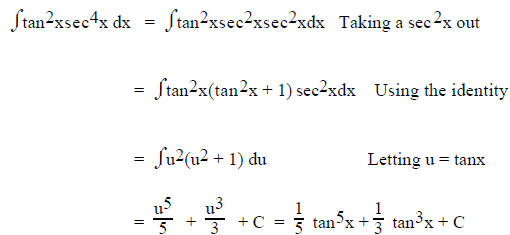INTEGRATION MATH 21 B
5. Algebraic Substitution. Let u = the part that is
keeping it from being an exponent
problem. [See I. A.]
This method is last in the list because it is not always
clear what to let u equal. Some people find this method
easy and use it instead of long division. The problem used as an example for
long division may be done using
this method by letting u = x + 1.
Recall that expressions in parentheses raised to a
fractional or negative power cannot be written as an exponent
problem. In this case it is often useful to let u = the part inside the
parentheses , solve for x and dx and then
substitute.
For example:
 Note the exponent outside the parentheses
Note the exponent outside the parentheses




II. Trig
A. Does the derivative of one part = the other part?
A word hear about memorization. It is critical that you
know your derivatives of the trig functions extremely
well. If not, you will have trouble recognizing that "the derivative of one part
= the other part."
1. If one trig term, let u = the angle.
For example:
 Letting u = 3x, du = 3dx
Letting u = 3x, du = 3dx  One trig term & the angle is 3x
One trig term & the angle is 3x

2. If more than one trig term, let u = one of the trig
terms

For example:
 Note that if u = tanx , du = sec2x dx so
Note that if u = tanx , du = sec2x dx so

B. Tricks
1. If powers of sines and/or cosines
a. If the power of sine or cosine is odd - take one from the sine or cosine
which is
raised to an odd power, use the identity sin2x + cos2x = 1 to rewrite the part
that
was changed and let u = the one you didn't change.
For example:
 Taking sinx from the one w/ the odd power
Taking sinx from the one w/ the odd power
 Using the identity to change sin2x
Using the identity to change sin2x
 letting u = cosx, du = -sinxdx
letting u = cosx, du = -sinxdx

b. If sine and/or cosine to even powers
use
 until there are no even
until there are no even
powers of sine or cosine left.
For example:
 Using the identities
Using the identities
 Algebra
Algebra
 Identity
Identity
 Identity
Identity

2. If sines and cosines with different angles. Use the
appropriate identity
sinA cosB =1/2 sin(A + B) + 1/2 sin(A - B),
sinA sinB = 1/2 cos(A - B) - 1/2 cos(A + B) or
cosA cosB = 1/2 cos(A - B) + 1/2 cos(A + B)
For example:
 Using the identity
Using the identity

3. If rational expression involving sine and/or cosine,
let
 then
then


For example:

 Using partial fractions (See I.C.2.)
Using partial fractions (See I.C.2.)
4. If powers of tangent and/or secant
a If the secant is to an even power - take sec2x from the secant term, change
remaining secant term to tangent using sec2x = tan2x + 1, let u = tanx
For example:

b. If tangent is to an odd power - take a secant and a
tangent from the integrand,
change the remaining tangent term to secant using tan2x = sec2x - 1 and let u
= secx.
For example:
 Factoring out tanx and secx
Factoring out tanx and secx
 Identity
Identity
 u
= secx
u
= secx

III. Mixture (some combination of algebra, trig,
inverse trig, logs and/or exponentials)
A. Does the derivative of one part = the other part?
Read the explanations in I. B. and II. A. again. It is
also critical to know the derivatives of
 ,ln f(x) and of
,ln f(x) and of
the inverse trig functions.
For example:
 Letting u = tanx
Letting u = tanx

B. Integration by parts - LIATE
The letters in the acronym stand for Logarithms, Inverse
trig, Algebra, Trig and Exponentials (ex not x3). It
usually works to let u = the part that comes first in the word, LIATE.
Recall that

For example:
 is composed of an Algebra part (x3) and a Log part (lnx). So let u = lnx (L
comes
is composed of an Algebra part (x3) and a Log part (lnx). So let u = lnx (L
comes
before A in LIATE). So u = lnx dv = x3dx (the rest of the
integrand) then

 Using the Int. by Parts Formula
Using the Int. by Parts Formula
 Algebra
Algebra


